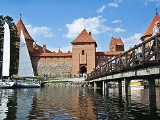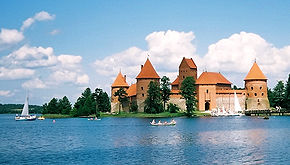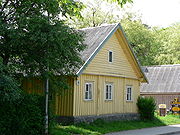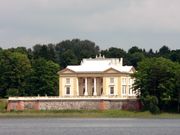
Trakai
Encyclopedia

, who became a governor of Lithuania Proper. However, his rule was briefly interrupted when in 1383 joint forces of Kęstutis's son Vytautas and the Teutonic Knights captured the town. In 1392 Vytautas and Jogaila signed Astrava Treaty ending their quarrel. Vytautas became the Grand Duke of Lithuania while Jogaila technically remained his superior. Vytautas also regained his father's lands, including Trakai. Despite his official capital being Vilnius, Vytautas spent more time in Trakai. In early 15th century he replaced the older, wooden fortress with a stone-built castle. Some design elements were borrowed from the castles of the Teutonic Knights as Vytautas spent some time with the Teutons forming an alliance against Jogaila in earlier years.

Magdeburg rights
Magdeburg Rights or Magdeburg Law were a set of German town laws regulating the degree of internal autonomy within cities and villages granted by a local ruler. Modelled and named after the laws of the German city of Magdeburg and developed during many centuries of the Holy Roman Empire, it was...
; it one of the first towns in Lithuania to get city rights. The village started rapidly developing into a town. In 1413 it became a seat of the Trakai Voivodeship
Trakai Voivodeship
Trakai Voivodeship, Trakai Palatinate, or Troki Voivodeship , was a unit of administrative division and local government in the Grand Duchy of Lithuania from 1413 until 1795.-History:...
and a notable center of administration and commerce.
Decline and reconstruction


Grand Duchy of Lithuania
The Grand Duchy of Lithuania was a European state from the 12th /13th century until 1569 and then as a constituent part of Polish-Lithuanian Commonwealth until 1791 when Constitution of May 3, 1791 abolished it in favor of unitary state. It was founded by the Lithuanians, one of the polytheistic...
joined the Kingdom of Poland
Kingdom of Poland (1385–1569)
The Kingdom of Poland of the Jagiellons was the Polish state created by the accession of Jogaila , Grand Duke of Lithuania, to the Polish throne in 1386. The Union of Krewo or Krėva Act, united Poland and Lithuania under the rule of a single monarch...
into Polish–Lithuanian Commonwealth in 1569, the castles remained a royal property, but the town's importance gradually declined, with the nearby Vilnius and the political center of the Commonwealth in Kraków
Kraków
Kraków also Krakow, or Cracow , is the second largest and one of the oldest cities in Poland. Situated on the Vistula River in the Lesser Poland region, the city dates back to the 7th century. Kraków has traditionally been one of the leading centres of Polish academic, cultural, and artistic life...
being far more important. Nevertheless, it continued to be the seat of local Sejmik
Sejmik
A sejmik was a regional assembly in the Polish–Lithuanian Commonwealth, and earlier in the Kingdom of Poland. Sejmiks existed until the end of the Commonwealth in 1795 following the partitions of the Commonwealth...
. In Polish sources the town name was started to be referred to as Troki. In 1477, the castle on the lake was a meeting place of king Casimir IV of Poland with Venetian
Venice
Venice is a city in northern Italy which is renowned for the beauty of its setting, its architecture and its artworks. It is the capital of the Veneto region...
envoys. After that the castle became a luxurious prison for political prisoners. Sigismund I the Old
Sigismund I the Old
Sigismund I of Poland , of the Jagiellon dynasty, reigned as King of Poland and also as the Grand Duke of Lithuania from 1506 until 1548...
imprisoned the members of Goštautai
Goštautai
Gostautai , masculine Gostautas and feminine form Gostautaite were a Lithuanian noble family, one of the most influential magnate families during the 15th and early 16th centuries...
family, believed to be conspiring with Michał Gliński. Also Helena, widow of Alexander of Poland was kept there in order to prevent her escape to Muscovy. The castle was refurbished by king Sigismund I the Old
Sigismund I the Old
Sigismund I of Poland , of the Jagiellon dynasty, reigned as King of Poland and also as the Grand Duke of Lithuania from 1506 until 1548...
, who set up his summer residence there; however, after his death in 1548 the castle gradually fell into disrepair.
During the wars between Russia and Poland
Russo-Polish War (1654–1667)
The Russo-Polish War of 1654–1667, also called Thirteen Years' War, First Northern War, War for Ukraine was the last major conflict between Tsardom of Russia and the Polish-Lithuanian Commonwealth. Between 1655 and 1660, the Second Northern War was also fought in the Polish-Lithuanian Commonwealth,...
between 1654 and 1667, the town was plundered and burnt. In the aftermath of the war with Muscovy in 1655, both castles were demolished and the town's prosperity ended. The castle ruins remained a historical landmark. During the Great Northern War
Great Northern War
The Great Northern War was a conflict in which a coalition led by the Tsardom of Russia successfully contested the supremacy of the Swedish Empire in northern Central Europe and Eastern Europe. The initial leaders of the anti-Swedish alliance were Peter I the Great of Russia, Frederick IV of...
(1700–1721) Trakai was plundered again, as famine and plague swept the country.
After the Partitions of Poland
Partitions of Poland
The Partitions of Poland or Partitions of the Polish–Lithuanian Commonwealth took place in the second half of the 18th century and ended the existence of the Polish–Lithuanian Commonwealth, resulting in the elimination of sovereign Poland for 123 years...
in 1795, the area was annexed by the Russian Empire
Russian Empire
The Russian Empire was a state that existed from 1721 until the Russian Revolution of 1917. It was the successor to the Tsardom of Russia and the predecessor of the Soviet Union...
. After World War I
World War I
World War I , which was predominantly called the World War or the Great War from its occurrence until 1939, and the First World War or World War I thereafter, was a major war centred in Europe that began on 28 July 1914 and lasted until 11 November 1918...
, the area was captured by the restored Republic of Poland
Second Polish Republic
The Second Polish Republic, Second Commonwealth of Poland or interwar Poland refers to Poland between the two world wars; a period in Polish history in which Poland was restored as an independent state. Officially known as the Republic of Poland or the Commonwealth of Poland , the Polish state was...
. In 1929, the Polish authorities ordered reconstruction and restoration of the Trakai Island Castle. The works in the Upper castle were almost complete in 1939, when the Polish Defensive War
Invasion of Poland (1939)
The Invasion of Poland, also known as the September Campaign or 1939 Defensive War in Poland and the Poland Campaign in Germany, was an invasion of Poland by Germany, the Soviet Union, and a small Slovak contingent that marked the start of World War II in Europe...
started and the area was soon annexed by the Soviet Union
Soviet Union
The Soviet Union , officially the Union of Soviet Socialist Republics , was a constitutionally socialist state that existed in Eurasia between 1922 and 1991....
, then by Nazi Germany during Operation Barbarossa
Operation Barbarossa
Operation Barbarossa was the code name for Germany's invasion of the Soviet Union during World War II that began on 22 June 1941. Over 4.5 million troops of the Axis powers invaded the USSR along a front., the largest invasion in the history of warfare...
. During the war, more than 5,000 Jews from the Trakai region were murdered by the Nazis. In 1944, during Operation Tempest
Operation Tempest
Operation Tempest was a series of uprisings conducted during World War II by the Polish Home Army , the dominant force in the Polish resistance....
, the town was liberated by joint forces of the underground Polish Home Army and Soviet partisans
Soviet partisans
The Soviet partisans were members of a resistance movement which fought a guerrilla war against the Axis occupation of the Soviet Union during World War II....
. After World War II
World War II
World War II, or the Second World War , was a global conflict lasting from 1939 to 1945, involving most of the world's nations—including all of the great powers—eventually forming two opposing military alliances: the Allies and the Axis...
it was again annexed by the Soviet Union
Soviet Union
The Soviet Union , officially the Union of Soviet Socialist Republics , was a constitutionally socialist state that existed in Eurasia between 1922 and 1991....
and made part of the Lithuanian SSR
Lithuanian SSR
The Lithuanian Soviet Socialist Republic , also known as the Lithuanian SSR, was one of the republics that made up the former Soviet Union...
in the Soviet Union
Soviet Union
The Soviet Union , officially the Union of Soviet Socialist Republics , was a constitutionally socialist state that existed in Eurasia between 1922 and 1991....
; subsequently many of the city's and area's ethnic Polish inhabitants left for the recovered Territories
Recovered Territories
Recovered or Regained Territories was an official term used by the People's Republic of Poland to describe those parts of pre-war Germany that became part of Poland after World War II...
of the People's Republic of Poland
People's Republic of Poland
The People's Republic of Poland was the official name of Poland from 1952 to 1990. Although the Soviet Union took control of the country immediately after the liberation from Nazi Germany in 1944, the name of the state was not changed until eight years later...
.
In 1961, the reconstruction of the upper castle and a high tower construction were completed; however, the works came to a halt as a result of Nikita Khrushchev
Nikita Khrushchev
Nikita Sergeyevich Khrushchev led the Soviet Union during part of the Cold War. He served as First Secretary of the Communist Party of the Soviet Union from 1953 to 1964, and as Chairman of the Council of Ministers, or Premier, from 1958 to 1964...
's speech of December 21, 1960. The Soviet First Secretary
General Secretary
The office of general secretary is staffed by the chief officer of:*The General Secretariat for Macedonia and Thrace, a government agency for the Greek regions of Macedonia and Thrace...
declared that reconstruction of the castle would be a sign of glorification of Lithuania's feudal
Feudalism
Feudalism was a set of legal and military customs in medieval Europe that flourished between the 9th and 15th centuries, which, broadly defined, was a system for ordering society around relationships derived from the holding of land in exchange for service or labour.Although derived from the...
past. Works in the lower castle were not resumed until the 1980s and were completed by the Lithuania
Lithuania
Lithuania , officially the Republic of Lithuania is a country in Northern Europe, the biggest of the three Baltic states. It is situated along the southeastern shore of the Baltic Sea, whereby to the west lie Sweden and Denmark...
n authorities in the early 1990s. Today the Island Castle serves as the main tourist attraction, hosting various cultural events such as operas and concerts.
Karaim community

Karaim language
The Karaim language is a Turkic language with Hebrew influences, in a similar manner to Yiddish or Ladino. It is spoken by Crimean Karaites – ethnic Turkic adherents of Karaite Judaism in Crimea, Lithuania, Poland and western Ukraine...
religious and ethnic group resettled to Trakai by Grand Duke Vytautas in 1397 and 1398 from Crimea
Crimea
Crimea , or the Autonomous Republic of Crimea , is a sub-national unit, an autonomous republic, of Ukraine. It is located on the northern coast of the Black Sea, occupying a peninsula of the same name...
, after one of his successful military campaigns against the Golden Horde
Golden Horde
The Golden Horde was a Mongol and later Turkicized khanate that formed the north-western sector of the Mongol Empire...
. Both Christian and Karaim communities were granted separate self-government in accordance with the Magdeburg rights
Magdeburg rights
Magdeburg Rights or Magdeburg Law were a set of German town laws regulating the degree of internal autonomy within cities and villages granted by a local ruler. Modelled and named after the laws of the German city of Magdeburg and developed during many centuries of the Holy Roman Empire, it was...
. Despite ever-increasing Polonisation, Trakai remained a notable center of Karaim cultural and religious life. Some famous scholars were active in Trakai in the 16th and 17th centuries, such as Isaac ben Abraham of Trakai
Isaac b. Abraham of Troki
Isaac ben Abraham of Troki, Karaite scholar and polemical writer Isaac ben Abraham of Troki, Karaite scholar and polemical writer Isaac ben Abraham of Troki, Karaite scholar and polemical writer (b. Trakai, Grand Duchy of Lithuania, c. 1533; d. Trakai, c. 1594 (or eight years earlier for both...
(1533–1594?), Joseph ben Mordecai Malinovski, Zera ben Nathan of Trakai, Salomon ben Aharon of Trakai, Ezra ben Nissan (died in 1666) and Josiah ben Judah (died after 1658). Some of the Karaims became wealthy and noble. The local Karaim community, the backbone of the town's economy, suffered severely during the Khmelnytsky Uprising
Khmelnytsky Uprising
The Khmelnytsky Uprising, was a Cossack rebellion in the Ukraine between the years 1648–1657 which turned into a Ukrainian war of liberation from Poland...
and the massacres of 1648. By 1680, only 30 Karaim families were left in the town. Their traditions, including not accepting neophytes, prevented the community from regaining its strength. Early in the 18th century war, famine, and plague
Bubonic plague
Plague is a deadly infectious disease that is caused by the enterobacteria Yersinia pestis, named after the French-Swiss bacteriologist Alexandre Yersin. Primarily carried by rodents and spread to humans via fleas, the disease is notorious throughout history, due to the unrivaled scale of death...
reduced the Karaims to three families. By 1765 Karaim community increased to 300. Trakai's Karaim kenesa
Kenesa
Kenesa is the term for a Karaite or Persian synagogue. The word derives from the Aramaic word for "assembly" .-Layout:...
is a rare example of a surviving wooden synagogue with an interior dome.
Twin towns — Sister cities
Trakai is twinnedTown twinning
Twin towns and sister cities are two of many terms used to describe the cooperative agreements between towns, cities, and even counties in geographically and politically distinct areas to promote cultural and commercial ties.- Terminology :...
with:
| Rheine Rheine Rheine is a city in the district of Steinfurt in Westphalia, Germany. It is the largest city in the district and the location of Rheine Air Base.-Geography:Rheine is located on the river Ems, approx. north of Münster, approx... , Germany Germany Germany , officially the Federal Republic of Germany , is a federal parliamentary republic in Europe. The country consists of 16 states while the capital and largest city is Berlin. Germany covers an area of 357,021 km2 and has a largely temperate seasonal climate... , since 1996 Malbork Malbork Malbork is a town in northern Poland in the Żuławy region , with 38,478 inhabitants . Situated in the Pomeranian Voivodeship since 1999, it was previously assigned to Elbląg Voivodeship... , Poland Poland Poland , officially the Republic of Poland , is a country in Central Europe bordered by Germany to the west; the Czech Republic and Slovakia to the south; Ukraine, Belarus and Lithuania to the east; and the Baltic Sea and Kaliningrad Oblast, a Russian exclave, to the north... , since 1997 Alanya Alanya Alanya , formerly Alaiye, is a beach resort city and a component district of Antalya Province in the Mediterranean Region of Turkey, from the city of Antalya. On the southern coast of Turkey, the district has an area of 1,598.51 km2 and 248,286 inhabitants... , Turkey Turkey Turkey , known officially as the Republic of Turkey , is a Eurasian country located in Western Asia and in East Thrace in Southeastern Europe... |
Nowy Sącz Nowy Sacz Nowy Sącz is a town in the Lesser Poland Voivodeship in southern Poland. It is the district capital of Nowy Sącz County, but is not included within the powiat.-Names:... , Poland Poland Poland , officially the Republic of Poland , is a country in Central Europe bordered by Germany to the west; the Czech Republic and Slovakia to the south; Ukraine, Belarus and Lithuania to the east; and the Baltic Sea and Kaliningrad Oblast, a Russian exclave, to the north... Giżycko Gizycko Giżycko is a town in northeastern Poland with 29,796 inhabitants . It is situated in the Warmian-Masurian Voivodeship , having previously been in the Suwałki Voivodeship . It is the seat of Giżycko County.-History:... , Poland Poland Poland , officially the Republic of Poland , is a country in Central Europe bordered by Germany to the west; the Czech Republic and Slovakia to the south; Ukraine, Belarus and Lithuania to the east; and the Baltic Sea and Kaliningrad Oblast, a Russian exclave, to the north... Ivano-Frankivsk Ivano-Frankivsk Ivano-Frankivsk is a historic city located in the western Ukraine. It is the administrative centre of the Ivano-Frankivsk Oblast , and is designated as its own separate raion within the oblast, municipality.... , Ukraine Ukraine Ukraine is a country in Eastern Europe. It has an area of 603,628 km², making it the second largest contiguous country on the European continent, after Russia... |
Yavoriv Yavoriv Yavoriv is a city located in the Lviv Oblast of western Ukraine. It is the administrative center of the Yavoriv Raion and rests approximately 50 km west of the oblast capital, Lviv.... , Ukraine Ukraine Ukraine is a country in Eastern Europe. It has an area of 603,628 km², making it the second largest contiguous country on the European continent, after Russia... Schönebeck Schönebeck Schönebeck is a town in the district of Salzlandkreis, in Saxony-Anhalt, Germany. It is situated on the left bank of the Elbe, approx. 14 km southeast of Magdeburg.-International relations:Schönebeck is twinned with:... , Germany Germany Germany , officially the Federal Republic of Germany , is a federal parliamentary republic in Europe. The country consists of 16 states while the capital and largest city is Berlin. Germany covers an area of 357,021 km2 and has a largely temperate seasonal climate... Borne, Netherlands Netherlands The Netherlands is a constituent country of the Kingdom of the Netherlands, located mainly in North-West Europe and with several islands in the Caribbean. Mainland Netherlands borders the North Sea to the north and west, Belgium to the south, and Germany to the east, and shares maritime borders... |
Jarosław, Poland Poland Poland , officially the Republic of Poland , is a country in Central Europe bordered by Germany to the west; the Czech Republic and Slovakia to the south; Ukraine, Belarus and Lithuania to the east; and the Baltic Sea and Kaliningrad Oblast, a Russian exclave, to the north... Târgovişte Târgoviste Târgoviște is a city in the Dâmbovița county of Romania. It is situated on the right bank of the Ialomiţa River. , it had an estimated population of 89,000. One village, Priseaca, is administered by the city.-Name:... , Rumania Bernburg Bernburg Bernburg is a town in Saxony-Anhalt, Germany, capital of the district of Salzlandkreis. It is situated on the river Saale, approx. 30 km downstream from Halle. The town is dominated by its huge Renaissance castle featuring a museum as well as a popular, recently updated bear pit in its... , Germany Germany Germany , officially the Federal Republic of Germany , is a federal parliamentary republic in Europe. The country consists of 16 states while the capital and largest city is Berlin. Germany covers an area of 357,021 km2 and has a largely temperate seasonal climate... |

